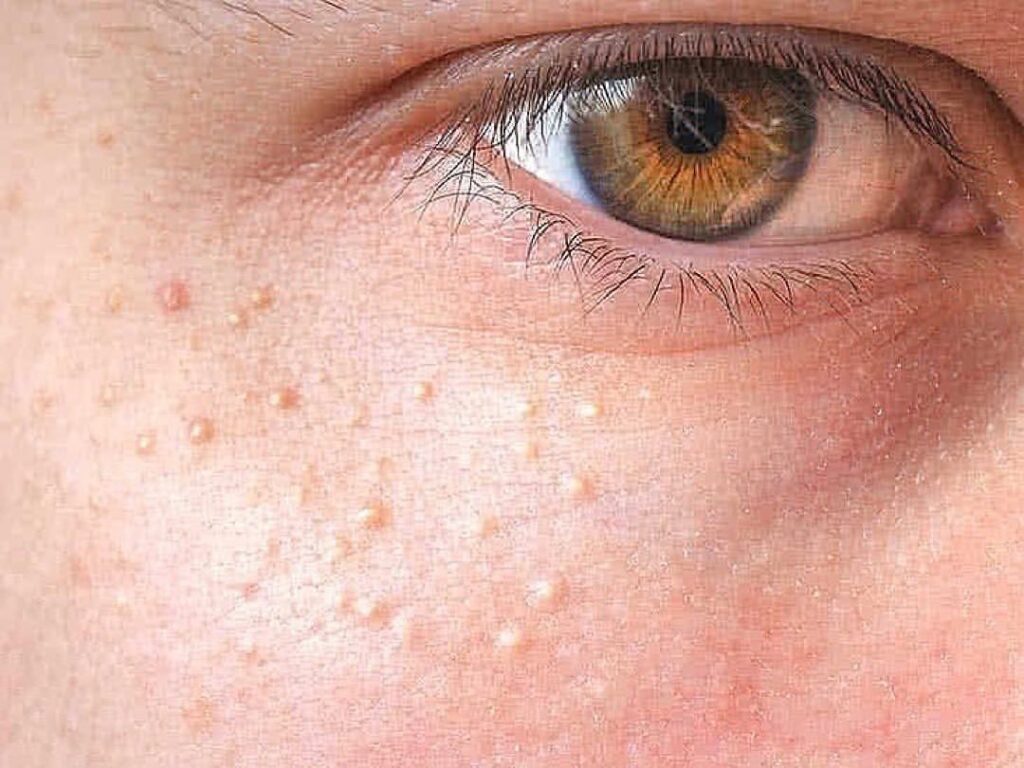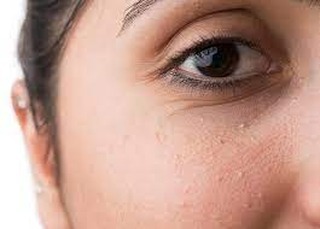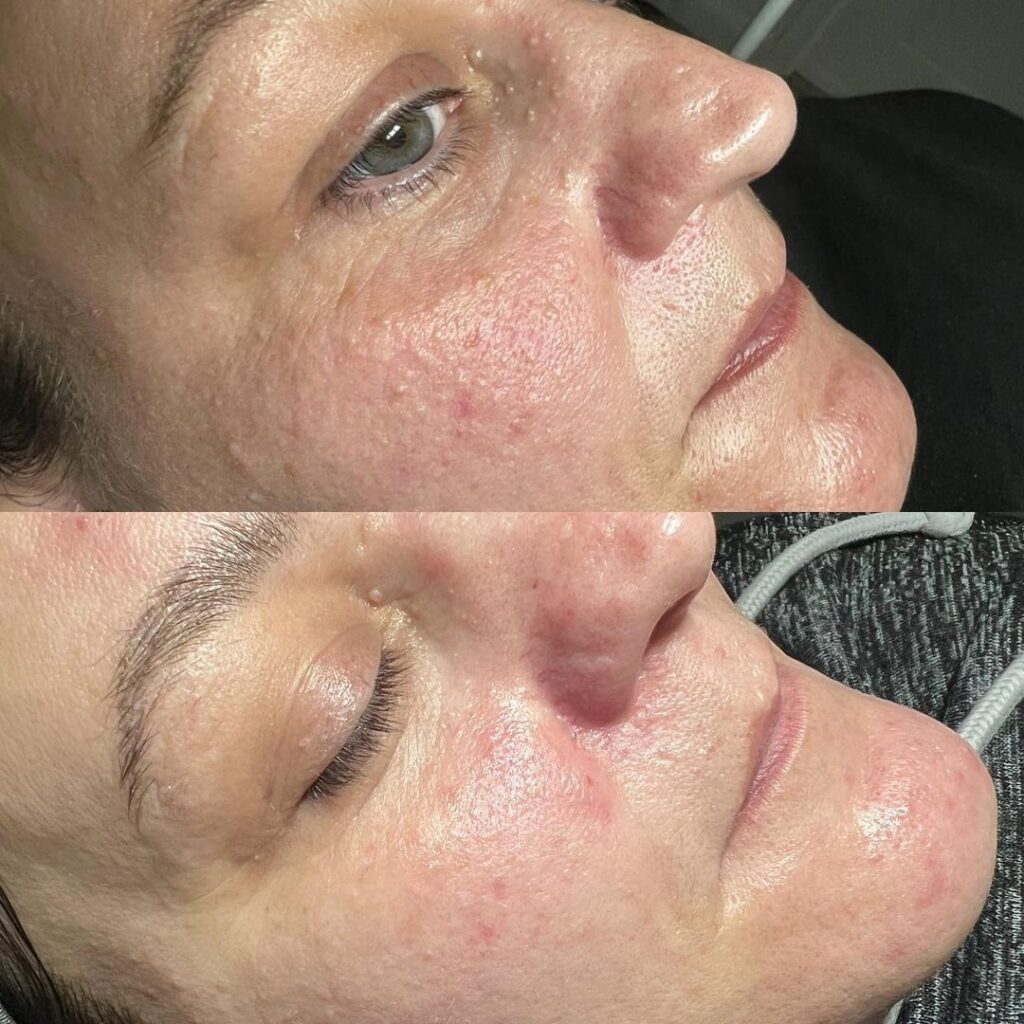Do you ever wonder about milia remover? Milia is a medical disorder in which a person develops tiny cysts just under the surface of their skin. They are often harmless but may be ugly if you have the condition that causes them. Ever have questions like, what are milia removal products? What is milia removal cream? How to remove milia at home with needle? Can you do milia removal at home? Can you remove it using milia remover? You’ll be relieved that they’re easy to get rid of, thanks to treatments that may be done topically, with lasers, or both.
Table of Contents
What is Milia and milia remover?

A milia is a specific cyst that may appear on the skin. Although it may manifest itself anywhere on the body, the area around the eyes is where it is most often seen. They are bumps that are loaded with keratin, a protein that may be found in skin cells. These bumps are white. They are often relatively little, but they have the potential to develop to reach at least the size of a pea.
They are harmless and do not produce any symptoms, yet, their appearance on the face may be unsightly and bothersome because of their unusual appearance. The good news is that they will often disappear without treatment within a few weeks to a few months on their own.
Symptoms of milia

They develop when keratin accumulates inside a hair follicle or oil gland. This accumulation plugs the pore and stops it from discharging its regular material, forming a small white bump. They are often seen around the eyes and cheeks, although they may also form anywhere on the face or body, including the hands and arms.
Its symptoms include:
- White to yellow lumps on the skin (cysts).
- Bumps may occur in clusters or groups.
- Bumps are asymptomatic and do not cause discomfort or suffering.
Depending on the kind of milia, some may be irritating or appear as a raised skin patch.
How to remove milia at home with milia remover
They are not like pimples; you shouldn’t attempt to pop them or scrap them off the skin as you would with a pimple with a milia remover. Using milia remover leave scars or trigger an infection on your skin. There are activities that you can do with milia remover at home that might be helpful, including the following:
- It would be best to wash your face with a mild cleanser and warm water daily. After that, pat your skin very gently until it is dry. Pat your skin dry.
- It is inappropriate to apply oils or lotions designed for adults to a baby’s skin. The skin of an infant is far too sensitive.
- Exfoliating their skin using a product purchased without a prescription is an option for adults.
- Use sunscreen when you go outside.
What are multiple eruptive milia?
They are keratinous cysts that are often small white, and benign. They are also quite common. Rarely seen, multiple eruptive milia are characterized by the emergence of it that are more extensive in quantity and dispersion than would be anticipated. This is in contrast to primary milia, which tend to be limited in both aspects.
What are neonatal milia primary?
Milia neonata is a skin condition that affects newborns and causes white cysts to grow on a baby’s skin, most often on or around the baby’s nose. This is present at the time of birth.
Milia primary is tiny cysts that may appear anywhere on the body, including the eyelids, the forehead, the cheeks, or the genital area. They affect adults as well as children.
Milia remover: Why do people get milia?
They are caused by dead skin cells that get trapped under the surface of your skin and form cysts. Your body will naturally shed dead skin cells to create a way for new cells to develop and replace the ones that have been lost. This process is called exfoliation. When dead skin cells do not shed naturally from the body, new skin cells develop on top of them and trap the dead cells beneath as they do so. The hardened remains of your dead skin cells develop into cysts.
It may also be caused by several factors, including:
- An injury or prolonged exposure to the sun may cause skin damage
- Utilization of steroid creams or ointments over an extended period
- A manifestation of a hereditary disease or defect
- An autoimmune reaction
Milia remover: How is it diagnosed?

After a physical examination and learning more about your symptoms, your healthcare professional may diagnose. A visual examination of the cysts on your skin provides an accurate diagnosis, and further testing is often unnecessary, particularly in infants. If additional skin examination is necessary, your doctor may order a skin biopsy. For this test, a little portion of your skin will be removed and examined under a microscope.
How is milia treated and the milia remover?

milia removal video all steps with :
They do not need treatment since they are harmless. If you dislike the appearance of it on your skin, see your healthcare practitioner about eradicating them. The removal of it might involve: Application of adapalene gel over-the-counter or tretinoin cream with a prescription.
Surgically remove it in your healthcare provider’s office by puncturing it with a needle and squeezing out the contents. Cryotherapy helps eradicate it from the skin by freezing them.
What is the fastest way to get rid of milia?
The fastest method for eliminating is to remove them using a needle. Milia are little white pimples that occur on the skin, often around the eyes. The removal of it may be performed by a dermatologist or at home using a needle. The operation is straightforward and takes around 5 minutes.
Can you squeeze out milia?
It cannot be removed by squeezing, and any attempt to do so is futile. When they are compressed, it may cause a lot of discomfort. If a milium is very big and painful, it is recommended not to squeeze it. Squeezing a milium increases the likelihood that it may become inflamed and infected.
Conclusion
In the event that you do have an issue with milia, there is no need for you to freak out. You do not have to get rid of them if they are not giving you any severe pain or discomfort since you may live very happily with them and there is no need to do so.
If you are seeking for a means to get rid of them, though, you may be asking how to cure it at home. It may be treated in a few different ways. This article will walk you through the many treatments that are available that are both successful and suitable for treating your problem.

